Sunday, January 02, 2005
Prospecting
Now that we've changed the oil, it's time to do some detective work on the old oil filter. This will involve cutting the filter open and inspecting the filter element for any debris that might be a sign of trouble within the engine. As even a healthy engine grinds its way towards its next overhaul (or its next catastrophic failure) it will normally generate a small amount of metallic debris in addition to the usual grit and grime associated with internal combustion. These impurities, as well as anything that sneaks past the air filter and survives the combustion cycle, will be trapped by the oil filter and will be noticeable when the filter is cut open and inspected. We'll be happy to find a small amount of debris in the filter. What we don't want to see is a considerable amount of metal particles, or valves, or camshafts, or pistons.
Before we start, here are a few safety issues to be aware of
- Many things in life are sharp. With the exception of cheese and some musical instruments, these sharp things can hurt you, so be careful.
- Used engine oil and petroleum solvents do not taste very good. Try not to drink them.
- If you are married, do not cut open your oil filter in the kitchen. If you are a bachelor, go ahead and do it there, but don't let your mother find out.
With that said, let's begin.
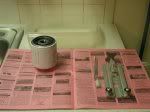 The materials we need are few, and consist primarily of the old filter and an oil filter cutter. Filter cutters are available from many aviation supply retailers. Sporty's has them, as does Aircraft Spruce. I got mine from Sporty's. It has the added advantage of being useful as a can opener. As such, it does a very good job since it removes the entire end of the can, allowing you to get all the soup out without cutting yourself. Let's face it, you already spend more money feeding the airplane than you do feeding yourself, so you'll need all the nourishment you can get. You'll also need a plastic tub to go prospecting in, and an old toothbrush to scrub the filter element. If you are a bachelor, you can use your regular toothbrush, but you can plan on remaining a bachelor if you do so.
The materials we need are few, and consist primarily of the old filter and an oil filter cutter. Filter cutters are available from many aviation supply retailers. Sporty's has them, as does Aircraft Spruce. I got mine from Sporty's. It has the added advantage of being useful as a can opener. As such, it does a very good job since it removes the entire end of the can, allowing you to get all the soup out without cutting yourself. Let's face it, you already spend more money feeding the airplane than you do feeding yourself, so you'll need all the nourishment you can get. You'll also need a plastic tub to go prospecting in, and an old toothbrush to scrub the filter element. If you are a bachelor, you can use your regular toothbrush, but you can plan on remaining a bachelor if you do so.
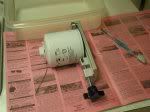 The first step is to place the filter in the cutter and tighten the vice screw enough to hold the filter firmly against the rollers. Don't try and puncture the filter at this time, you'll only dent it. If you enjoy bloodshed, you can leave the safety wire on the filter like I did.
The first step is to place the filter in the cutter and tighten the vice screw enough to hold the filter firmly against the rollers. Don't try and puncture the filter at this time, you'll only dent it. If you enjoy bloodshed, you can leave the safety wire on the filter like I did.
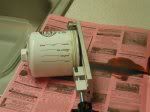 Then, rotate the filter while tightening the vice screw every few turns. It will take some time, but eventually you'll see that the cutting blade is doing its job.
Then, rotate the filter while tightening the vice screw every few turns. It will take some time, but eventually you'll see that the cutting blade is doing its job.
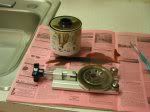 The end of the filter will come loose when its ready. Don't ask me why, but I find this photo very unnerving.
The end of the filter will come loose when its ready. Don't ask me why, but I find this photo very unnerving.
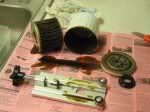 Here we see the filter cartridge removed from the canister. It's pretty messy, so don't wear your good clothes, unless you're a bachelor and they already have oil stains on them.
Here we see the filter cartridge removed from the canister. It's pretty messy, so don't wear your good clothes, unless you're a bachelor and they already have oil stains on them.
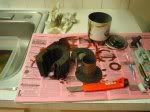 Next, use a sharp utility knife to cut the paper filter element from the cartridge. At this point, you can discard everything but the filter element, although the filter canister can make a nice coffee cup once you file the cut edge smooth.
Next, use a sharp utility knife to cut the paper filter element from the cartridge. At this point, you can discard everything but the filter element, although the filter canister can make a nice coffee cup once you file the cut edge smooth.
 Pour some solvent (mineral spirits works, as will Stoddard solvent) in the tub and start scrubbing the pleats of the filter element with the old toothbrush. You only need to scrub the outside of the element, but you can do both sides if you are anal, or if you forgot which side was the outer one.
Pour some solvent (mineral spirits works, as will Stoddard solvent) in the tub and start scrubbing the pleats of the filter element with the old toothbrush. You only need to scrub the outside of the element, but you can do both sides if you are anal, or if you forgot which side was the outer one.
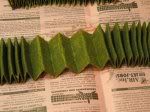 After squeezing out the excess oil and solvent, visually inspect the pleats for anything, particularly shiny metal particles, that may be caught in the element. It's a good idea to pass a magnet over the surface to see if it picks up anything ferrous.
After squeezing out the excess oil and solvent, visually inspect the pleats for anything, particularly shiny metal particles, that may be caught in the element. It's a good idea to pass a magnet over the surface to see if it picks up anything ferrous.
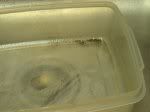 Next, carefully pour out the solvent and oil still remaining in the tub. A coffee filter or piece of chamois cloth can be used to strain the runoff. You are interested in what's left behind, so don't pour that out. Again take your magnet and pass it through the debris at the bottom of the tub. A small amount of fine powder and grit as shown here is normal, as is a small amount of metal particles. My mechanic said that if the collected debris will fit on a fingernail, then it's generally no cause for concern. That's a pretty subjective evaluation - if you find a lot of metal, ground your plane and have your mechanic look at the debris to see if it warrants closer examination of the engine.
Next, carefully pour out the solvent and oil still remaining in the tub. A coffee filter or piece of chamois cloth can be used to strain the runoff. You are interested in what's left behind, so don't pour that out. Again take your magnet and pass it through the debris at the bottom of the tub. A small amount of fine powder and grit as shown here is normal, as is a small amount of metal particles. My mechanic said that if the collected debris will fit on a fingernail, then it's generally no cause for concern. That's a pretty subjective evaluation - if you find a lot of metal, ground your plane and have your mechanic look at the debris to see if it warrants closer examination of the engine.
Finally, dispose of the old filter pieces, the oil and solvent, and any other oily refuse in accordance with applicable standards of good environmental stewardship. That means don't leave it all in the kitchen wastebasket - unless you're a bachelor.
